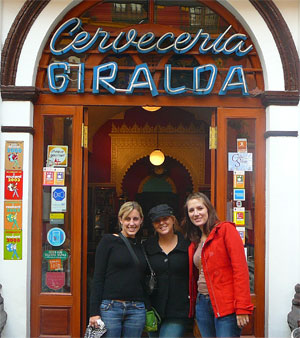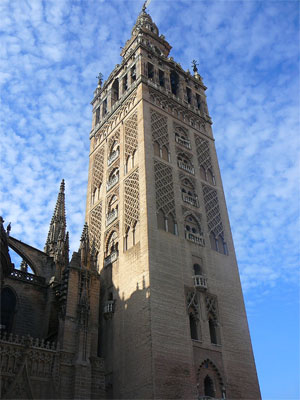Semester at
Sea Fall
2006 Voyage 
- Home Page
- My bio
- "Comparative Global
Cities Project"
- Vietnam:War Tours?
- China: Brought to you by American Express
- Burma: The World's Secret Garden
- Egypt: Somewhere in the Middle
- Spain: Transnational Flamenco
- Turkey: Beauty and Benefits of
a Global City
- Open Letter
Transnational Flamenco
By: Danica Taylor
 What an
amazing country
What an
amazing country
In addition
to the Cathedral of
Seville,  we also saw a
traditional flamenco song and dance in a local
bar one
night. Although in the article, “The City as a Stage: Flamenco in
Andalusian
culture” author Maria Papavlou makes a clear argument that Flamenco
began in an
Andalusian area of Spain called Jerez de la Frontera, it is still a
main part
of Spanish culture. Many Flamenco artists describe Flamenco as “running
through
your blood, through your veins…you are born with it and it can be
naturally
inherited to the next generations” (Papavlou, 15). As we were watching
the
show, I could feel that these dancers love what they do, that it truly
is a
part of them and a way they unite themselves with their cultural past.
We
talked to one of the dancers and she said that flamenco has been in her
family
from as far back as they can trace. It’s interesting to me to think
that at one
point in time they were performing for enjoyment and pleasure simply a
way to exercise,
perform and please their peers. However, as the world has become more
transnational and the Spanish economy and government has become open to
the
world, so have all the cultural traditions. Now although locals still
enjoy a
traditional song and dance, it is as much for them as it is a way to
earn a
living by performing to the tourists that have begun visiting
we also saw a
traditional flamenco song and dance in a local
bar one
night. Although in the article, “The City as a Stage: Flamenco in
Andalusian
culture” author Maria Papavlou makes a clear argument that Flamenco
began in an
Andalusian area of Spain called Jerez de la Frontera, it is still a
main part
of Spanish culture. Many Flamenco artists describe Flamenco as “running
through
your blood, through your veins…you are born with it and it can be
naturally
inherited to the next generations” (Papavlou, 15). As we were watching
the
show, I could feel that these dancers love what they do, that it truly
is a
part of them and a way they unite themselves with their cultural past.
We
talked to one of the dancers and she said that flamenco has been in her
family
from as far back as they can trace. It’s interesting to me to think
that at one
point in time they were performing for enjoyment and pleasure simply a
way to exercise,
perform and please their peers. However, as the world has become more
transnational and the Spanish economy and government has become open to
the
world, so have all the cultural traditions. Now although locals still
enjoy a
traditional song and dance, it is as much for them as it is a way to
earn a
living by performing to the tourists that have begun visiting
There are
few foreigners I’ve talked
to who have traveled to